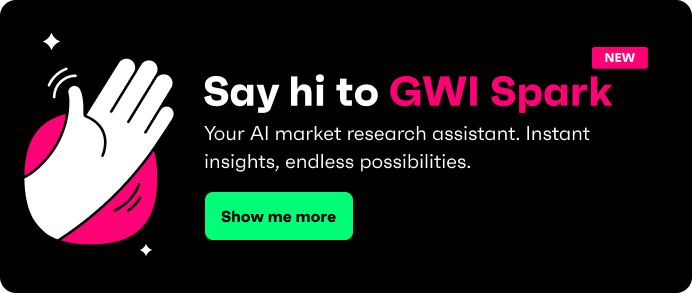
What separates standout brands from the rest? It’s not just luck or great ideas. It’s knowing your audience, validating your hunches, and backing every move with insight, not instinct. That’s why every brand needs market research.
Whether you’re launching a campaign, building a product, or pitching for new business, market research keeps your strategy grounded in facts. And the good news? You don’t need to be a data analyst or sit through weeks of fieldwork to make it happen. With new tools like GWI Spark, high-quality, real-time research is now just a few clicks away.
This guide is built for marketers, strategists, and business teams who want to lead with data and make decisions they can stand behind.
Why knowing how to do market research drives smarter business decisions
Market research is the difference between acting with confidence and flying blind. It helps you validate ideas, reduce risk, and focus your efforts where they’ll have the most impact.
Planning a campaign? Research helps you figure out what resonates and where your audience hangs out. Launching in a new market? It shows whether demand is strong and who your competitors are. Want to evolve your product? Feedback reveals which features matter most.
When teams have research capabilities in-house or at their fingertips through tools like GWI, they’re not waiting on lengthy reports or second-guessing their next move. They’re making decisions with real data in hand. That’s a serious competitive edge.
What is market research and why does it matter?
Market research is how businesses gather and analyze information about consumers, competitors, and market conditions. It helps answer the big questions: Who are our customers? What do they want? Where’s the opportunity?
It’s what turns guesswork into insight and assumptions into facts. Without it, strategies are built on shaky ground.
Traditionally, research could be slow, costly, and out of reach for smaller teams. But that’s changing. With platforms like GWI Spark, you can explore verified consumer data across 50+ markets in seconds. No lengthy setup. No deep-dive analytics required. Just ask a question and get reliable, ready-to-use insights.
The main types of market research (and when to use each)
There’s no single route to consumer insight. The best approach depends on what you need to know, and how quickly you need to know it.
Start with qualitative research to dig into motivations and test assumptions. Then bring in quantitative data to validate demand, pricing, and preferences at scale.
To build a new audience profile or refine targeting, consumer research gives you a rounded view of lifestyles, values, and behaviors. It’s perfect for crafting personas that reflect real people.
Working on brand health? That’s where brand research comes in. It measures how your brand is seen, how loyal your audience is, and whether your positioning is hitting the mark. Planning a launch? Product research helps fine-tune features, test user experience, and find gaps your competitors haven’t filled.
Primary research puts you in control. You gather insights firsthand through surveys or interviews. Secondary research draws on what’s already out there. It’s ideal when you need fast context from reports or third-party data.
Tools like GWI let you combine these methods effortlessly. You can move between qualitative and quantitative, zoom out for trends, or zoom in for specific audience behavior.
Step-by-step: How to do market research today
Let’s break it down into five clear steps, built around modern workflows and powered by instant-access tools like GWI Spark.
1. Define your objective
Start with the problem. Are sales flat? Is a campaign underperforming? Are you exploring a new audience or market? Clear objectives keep your research focused and actionable.
2. Choose your research type
Choose qualitative methods to explore motivations and get deeper insights. Use quantitative ones to test theories at scale. Primary research gives you fresh, bespoke answers. Secondary research helps when time is tight or you need added context.
3. Identify your audience
Who are you researching? Nail this and the rest becomes much easier. With GWI Spark, you can build custom audiences based on demographics, behaviors, attitudes, and even niche attributes, then compare and analyze them in seconds.
4. Collect and analyze data
Run your surveys, review reports, or explore platforms like GWI for real-time insights. You can dig into global trends, zoom in on specific regions, and uncover patterns at a glance. Built-in visualizations, AI-generated highlights, and smart search features make data analysis in market research fast and intuitive.
5. Apply insights to your strategy
Now turn research into action. Use what you’ve learned to refine your targeting, personalize your messaging, or pivot your product roadmap. Real insights give you the confidence to make bold moves. You’ll know they’re backed by data.
The role of GWI Spark in modern market research
GWI Spark isn’t just another research tool. It’s a fast, intuitive way to get straight to the insights you need. No expertise required.
You ask a question in plain language, and GWI Spark pulls reliable data from nearly a million consumers surveyed globally. Want to compare Gen Z in Germany with millennials in Mexico? Explore brand loyalty in skincare buyers? Validate a pitch for a potential partner? You can do it all in seconds.
Features like customizable charts, pinned insights, and built-in AI help you explore trends, compare audiences, and pull together data-driven stories for everything from campaign briefs to product decks. It’s already a go-to for sales, content, product, and media teams who need insights at speed.
When to use market research in your business strategy
Market research works best when it’s baked into your day-to-day. It shouldn’t only come into play for big decisions.
Even once you’ve launched your new product or campaign, market research plays a role. It can validate your campaign performance, benchmark your brand against competitors, or guide product updates based on shifting needs.
Conclusion: Turn research into action
Market research isn’t just something for analysts and agencies. It’s for anyone who wants to make better decisions and build with confidence.
With modern tools like GWI Spark, the barriers are gone. No more delays. No more data silos. No more guesswork. Just fast, reliable insights you can act on right away.
Try GWI Spark today and start building a strategy that hits different. It's backed by real people, real data, and real insight.




.webp?width=495&height=317&name=pink_thumb_graphs%20(1).webp)
.webp?width=495&height=317&name=pink_thumb_letter%20(2).webp)